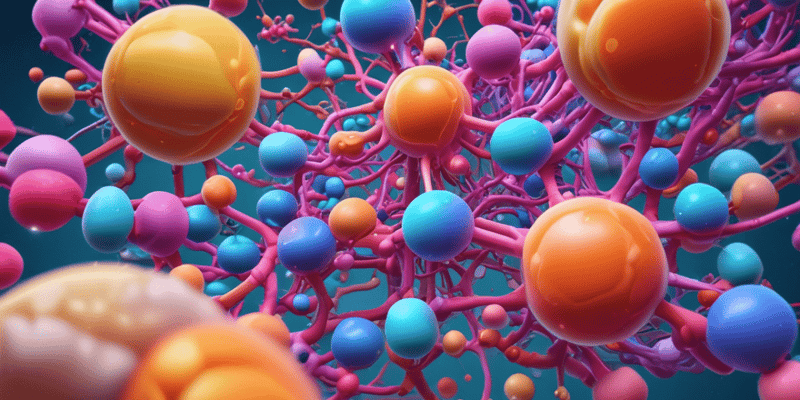Podcast Beta
Questions and Answers
What is the main process by which drugs produce their effects in the body?
Which drug mechanism involves drugs interacting with specific receptors?
What is primarily responsible for the metabolism of drugs in the body?
What does the dose-response relationship in toxicology describe?
Signup and view all the answers
What is the focus of pharmacogenomics?
Signup and view all the answers
What does therapeutic drug monitoring aim to optimize?
Signup and view all the answers
Which of the following is not a type of toxic agent?
Signup and view all the answers
What process refers to the removal of drugs from the body?
Signup and view all the answers
What is the primary action of non-opioid analgesics?
Signup and view all the answers
Which of the following medications is an example of an opioid analgesic?
Signup and view all the answers
Adjuvant analgesics are primarily used for which purpose?
Signup and view all the answers
What is a common side effect of opioid analgesics?
Signup and view all the answers
Which route of administration is often used for rapid relief in emergencies?
Signup and view all the answers
What is a potential risk associated with the use of opioid analgesics?
Signup and view all the answers
What is the primary use of corticosteroids as adjuvant analgesics?
Signup and view all the answers
Why is pain assessment crucial in analgesic selection?
Signup and view all the answers
Study Notes
Drug Mechanisms
- Definition: The process by which drugs produce their effects in the body.
-
Types of Mechanisms:
- Receptor Binding: Drugs interact with specific receptors (e.g., agonists activate receptors, antagonists block them).
- Enzyme Inhibition: Drugs can inhibit enzyme activity, altering biochemical pathways (e.g., ACE inhibitors).
- Ion Channel Modulation: Drugs can open or close ion channels affecting cellular excitability (e.g., local anesthetics).
- Transporter Interaction: Drugs may block or enhance the action of transport proteins (e.g., SSRIs).
Toxicology
- Definition: The study of the harmful effects of substances on living organisms.
-
Key Concepts:
- Dose-Response Relationship: The relationship between the dose of a substance and the magnitude of its toxic effect.
- Toxicokinetics: Study of how a substance is absorbed, distributed, metabolized, and excreted in the body.
-
Types of Toxic Agents:
- Chemical: Pharmaceuticals, environmental toxins, heavy metals.
- Biological: Bacteria, viruses, fungi, and plant toxins.
- Antidotes: Substances used to counteract the effects of poisons (e.g., naloxone for opioid overdose).
Pharmacokinetics
- Definition: The study of how the body affects a drug over time.
-
Key Processes:
- Absorption: How a drug enters the bloodstream (factors: route of administration, formulation).
- Distribution: Dispersion of the drug throughout body fluids and tissues (influenced by blood flow, protein binding).
- Metabolism: Biochemical modification of drugs, primarily in the liver (phase I: oxidation, reduction; phase II: conjugation).
- Excretion: Removal of the drug from the body, primarily through urine (renal function is critical).
Clinical Pharmacology
- Definition: The study of drugs in humans and their clinical applications.
-
Focus Areas:
- Therapeutic Drug Monitoring: Measuring drug levels to optimize efficacy and minimize toxicity.
- Pharmacogenomics: Study of how genetic factors influence drug response.
- Clinical Trials: Phases of drug development assessing safety, efficacy, and dosing in humans.
- Drug Interactions: Understanding how different drugs affect one another, impacting therapeutic outcomes.
These topics provide a foundational understanding of pharmacology, crucial for studying drug actions and their implications in healthcare.
Drug Mechanisms
- Mechanisms describe how drugs exert their effects on biological systems.
- Receptor Binding: Drugs can act as agonists, which activate receptors, or antagonists, which inhibit receptor activity.
- Enzyme Inhibition: Certain drugs inhibit enzyme functions, modifying biochemical pathways; example includes ACE inhibitors used for hypertension.
- Ion Channel Modulation: Drugs can either increase or decrease the activity of ion channels, impacting cell excitability (e.g., local anesthetics block nerve conduction).
- Transporter Interaction: Some drugs, like SSRIs, interfere with transporter proteins, affecting neurotransmitter levels in the brain.
Toxicology
- Toxicology examines the adverse effects of substances on living organisms.
- Dose-Response Relationship: This concept describes how the intensity of a toxic effect correlates to the amount of substance exposure.
- Toxicokinetics: Focuses on the absorption, distribution, metabolism, and excretion of toxic agents in the body.
-
Types of Toxic Agents:
- Chemical Toxins: Include pharmaceuticals, industrial chemicals, and heavy metals.
- Biological Toxins: Comprise pathogens like bacteria and viruses, alongside toxins from plants and fungi.
- Antidotes: Specific substances that neutralize poison effects; for instance, naloxone counteracts opioid overdoses.
Pharmacokinetics
- Pharmacokinetics studies the time course of a drug's journey through the body.
- Absorption: Refers to the process of a drug entering the bloodstream, influenced by the administration route and drug formulation.
- Distribution: Concerns how a drug spreads throughout bodily fluids and tissues, affected by factors such as blood flow and protein binding.
- Metabolism: Primarily occurs in the liver, involving drug transformation into metabolites; includes phase I (oxidation, reduction) and phase II (conjugation) reactions.
- Excretion: Describes the process of drug elimination, mainly through urine, emphasizing the importance of renal function.
Clinical Pharmacology
- Clinical pharmacology focuses on the application and study of drugs in human patients.
- Therapeutic Drug Monitoring: The practice of measuring drug concentrations to enhance therapeutic effects and reduce toxicity risks.
- Pharmacogenomics: Investigates genetic variations that influence individual responses to drugs, paving the way for personalized medicine.
- Clinical Trials: Structured phases of drug development where safety, effectiveness, and dosing are evaluated in human subjects.
- Drug Interactions: Understanding the interactions between different medications, crucial for ensuring effective treatment and avoiding adverse effects.
These topics collectively establish a critical foundation for comprehending pharmacology's complexities and its significant role in healthcare.
Analgesics Overview
- Analgesics are pain-relieving medications that do not induce loss of consciousness.
Types of Analgesics
-
Non-opioid Analgesics
- Includes Acetaminophen (Paracetamol) and NSAIDs like Ibuprofen, Aspirin, and Naproxen.
- Mechanism involves inhibition of cyclooxygenase (COX) enzymes, reducing pain mediators called prostaglandins.
- Effective for mild to moderate pain, inflammation, and fever reduction.
-
Opioid Analgesics
- Includes medications like Morphine, Codeine, Oxycodone, and Fentanyl.
- Operate by binding to opioid receptors in the brain and spinal cord, affecting pain perception.
- Suitable for moderate to severe pain, often employed after surgery or for chronic conditions.
- Risks include addiction, tolerance development, and respiratory depression.
-
Adjuvant Analgesics
- Includes antidepressants (e.g., Amitriptyline), anticonvulsants (e.g., Gabapentin), and corticosteroids.
- They enhance the effectiveness of other analgesics or specifically target certain types of pain, such as neuropathic pain.
- Typically used alongside other analgesics to improve overall pain management.
Routes of Administration
- Oral: Preferred route for many non-opioid and some opioid analgesics.
- Parenteral: Intravenous or intramuscular route provides rapid pain relief, particularly in emergency settings.
- Transdermal: Uses patches for continuous medication release, as seen with Fentanyl.
- Topical: Creams or patches like Lidocaine are applied directly to target painful areas.
Side Effects
- Non-opioid: May cause gastrointestinal disturbances or liver toxicity, especially with high doses of acetaminophen.
- Opioid: Side effects can include constipation, nausea, sedation, and respiratory depression.
- Adjuvant: Side effects vary by drug, commonly including dizziness, dry mouth, and weight gain.
Considerations in Pain Management
- Pain Assessment: Crucial for selecting the appropriate analgesic.
- Risk of Dependence: Monitoring is vital for patients on opioids to prevent dependency issues.
- Combination Therapy: Often effective for managing complex pain situations through a multi-faceted approach.
Studying That Suits You
Use AI to generate personalized quizzes and flashcards to suit your learning preferences.
Description
Explore the mechanisms by which drugs affect the body and the study of toxic substances in this quiz. Understand key concepts such as receptor binding, enzyme inhibition, and the dose-response relationship. Test your knowledge on how various substances interact with biological systems and their potential harmful effects.




